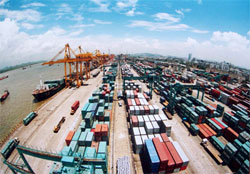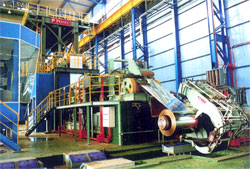Economy
Economy
 Jiangsu has an extensive irrigation system supporting its agriculture, which is based primarily on rice and wheat, followed by maize and sorghum. Main cash crops include cotton, soybeans, peanuts, rape, sesame, ambary hemp, and tea. Other products include peppermint, spearmint, bamboo, medicinal herbs, apples, pears, peaches, loquats, ginkgo. Silkworms also form an important part of Jiangsu's agriculture, with the Lake Taihu region to the south a major base of silk production in China. Jiangsu is also an important producer of freshwater fish and other aquatic products.
Jiangsu has an extensive irrigation system supporting its agriculture, which is based primarily on rice and wheat, followed by maize and sorghum. Main cash crops include cotton, soybeans, peanuts, rape, sesame, ambary hemp, and tea. Other products include peppermint, spearmint, bamboo, medicinal herbs, apples, pears, peaches, loquats, ginkgo. Silkworms also form an important part of Jiangsu's agriculture, with the Lake Taihu region to the south a major base of silk production in China. Jiangsu is also an important producer of freshwater fish and other aquatic products.
Jiangsu has coal, petroleum, and natural gas deposits, but its most significant mineral products are non-metal minerals such as halite (rock salt), sulfur, phosphorus, and marble. The salt mines of Huaiyin have more than 0.4 trillion tonnes of deposits, one of the greatest collections of deposits in China.
Jiangsu is historically oriented towards light industries such as textiles and food industry. Since 1949, Jiangsu has also developed heavy industries such as chemical industry and construction materials. Jiangsu's important industries include machinery, electronic, chemicals, and automobile [1]. Recently the government has worked hard to promote the solar industry and hopes by 2012 the solar industry will be worth 100 Billion RMB.[2] The economic reforms of Deng Xiaoping has greatly benefited southern cities, especially Suzhou and Wuxi, which outstrip the provincial capital Nanjing in total output. In the eastern outskirts of Suzhou, Singapore has built the Suzhou Industrial Park, a flagship of PRC-Singapore cooperation and the only industrial park in China that is in its entirety the investment of one single foreign country. Jiangsu is very wealthy among the provinces of China, with the third highest total GDP, after Guangdong and Shandong Province. Its GDP per capita was 39,526 yuan in 2008, but geographical disparity is great, and southern cities like Suzhou and Wuxi have GDP per capita around twice the provincial average, making south Jiangsu one of the most prosperous regions in China.
Jiangsu is very wealthy among the provinces of China, with the third highest total GDP, after Guangdong and Shandong Province. Its GDP per capita was 39,526 yuan in 2008, but geographical disparity is great, and southern cities like Suzhou and Wuxi have GDP per capita around twice the provincial average, making south Jiangsu one of the most prosperous regions in China.
In 2008, Jiangsu's nominal GDP was 3.03 trillion yuan (ca.US$435 billion), making it the third largest GDP of all the provinces and an annual growth rate of 12.5%. Its per capita GDP was 39,526 yuan (ca.US$5,700). In 2008, the share of GDP of Jiangsu's primary, secondary, and tertiary industries were 6.9%, 55.0%, and 38.1% respectively. The share of GDP by the public and private sector was 49.0% and 51.0% respectively.
Economic and Technological Development Zones
Changzhou New & High-Tech Industrial Development Zone
Kunshan Economic and Technological Development Zone
Kunshang Export Processing Zone
Jiangsu Taihu Lake National Tourist Holiday Resort
Nanjing New & Hi-Tech Industrial Development Zone
Nanjing Economic and Technological Development Zone
Nanjing Export Processing Zone (South Zone)
Nantong Economic & Technological Development Area
Nantong Export Processing Zone
Lianyungang Economic and Technological Development Zone
Lianyungang Export Processing Zone
Suzhou Industrial Park Export Processing Zone
Suzhou New & Hi-Tech Export Processing Zone
Suzhou Industrial Park
Suzhou National New & Hi-Tech IdustrialDevelopment Zone
Wuxi New District
Wuxi Export Processing Zone
Yixing Technological Industrial
Zhenjiang Export Processing Zone
Zhangjiagang Free Trade Zone Economic and Technological Development Zones